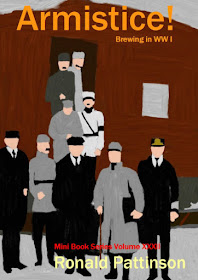Though, obviously, it is an Imperial Stout. The OG is a bit lower than the Barclay’s version, which was over 1100º, but it’s still a pretty powerful Stout. I think even I would make do with just a couple of pints.
The grist is the classic London combination of pale, brown and black malt. The capital’s brewers were faithful to brown malt to the bitter end. Most provincial breweries had ditched before 1900. And to those style Nazis who think that roast barley is the defining feature of Stout, I’ll point out that it was almost never used in London. And that is the city where the style was invented.
It’s heavily hopped with a combination of English and Hallertau hops. I’ve knocked the hopping rate down a bit because the hops were from the 1912 and 1913 seasons. You could swap the Fuggles for Goldings. This was an expensive beer, so might well have included posh hops. But, it was also parti-gyled with Porter, which was a cheap beer. Take your pick.
As the original would have had a secondary conditioning before sale, I’ve dropped the FG down from the racking gravity of 1039. I know from consulting both the brewing records and analyses of the finished beer that the gravity of Barclay’s Imperial Stout fell considerably after racking. Like that, Courage’s Imperial Stout would also have been vatted and most likely worked on by Brettanomyces.
| 1914 Courage Imperial Stout | ||
| pale malt | 13.00 lb | 60.47% |
| brown malt | 4.25 lb | 19.77% |
| black malt | 2.25 lb | 10.47% |
| No. 4 invert sugar | 2.00 lb | 9.30% |
| Fuggles 120 mins | 2.00 oz | |
| Fuggles 60 mins | 2.00 oz | |
| Hallertau 30 mins | 1.00 oz | |
| OG | 1094 | |
| FG | 1025 | |
| ABV | 9.13 | |
| Apparent attenuation | 73.40% | |
| IBU | 42 | |
| SRM | 73 | |
| Mash at | 152º F | |
| Sparge at | 165º F | |
| Boil time | 120 minutes | |
| pitching temp | 58º F | |
| Yeast | Wyeast 1099 Whitbread Ale | |
This an excerpt from my book on brewing in WW I, Armistice!
Buy this wonderful book.


No roast barley, 9%, Bretted... I'm trying to imagine what this would actually have tasted like, and I'm drawing a bit of a blank. I guess some of those barrel-aged impy stouts that all the cool kids do wouldn't be a mile off - but they tend to be sweeter than this would have been, and less funky. Perhaps if you made a Black & Tan with Guinness FES and Orval, and then topped it up with vodka...
ReplyDeletePhil, I realize it's not quite what you're asking, but Mike Tonsmeire brewed the other Courage RIS and you can read his tasting notes (they are linked at the bottom of the post):
ReplyDeletehttps://www.themadfermentationist.com/2007/11/courage-russian-imperial-stout.html
Different beer, but similar in that it had no roasted barley and had Brettanomyces added.
By the way, I've read a lot of Ron's stout recipes, and roasted barley is not that common an ingredient. One brewery cleverly used it as the non-malted grain that the government required during WWII, but apart from that black malt is much more common.
Hello, Ron. I'm looking at brewing this and have a question for you. Compared to Kristen's recipe back in 2012, you've removed the dry hops and added a 120m bittering. Could you provide some insight on that change? Thank you.
ReplyDeleteDBHOMEBREW,
ReplyDeleteas there are no details of the additions nor of the dry hopping, those can only be guesses. And Kristen and I have guessed differently.
Thank you, Ron. That leaves some freedom to draw from the two. Off to cook up some #4...
ReplyDeleteThis beer is in the fermenter. Gravity sample tasted really good. Syrupy, sweet. Chocolate, coffee, toffee. Using Kristen's hopping, moderate bitterness.
ReplyDeleteI'm really liking forward to how this turns out. Maybe I'll sneak a first tasting at New Year's.
Thanks again, Ron. Love your blog and really appreciate the historic context.